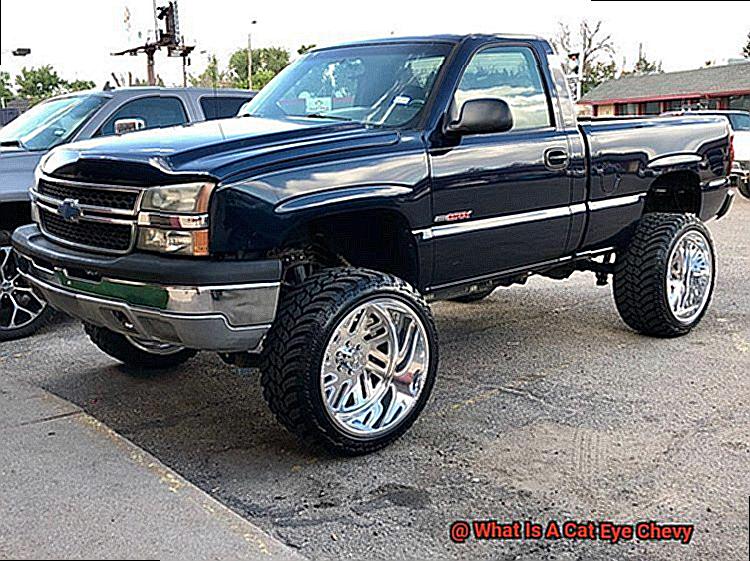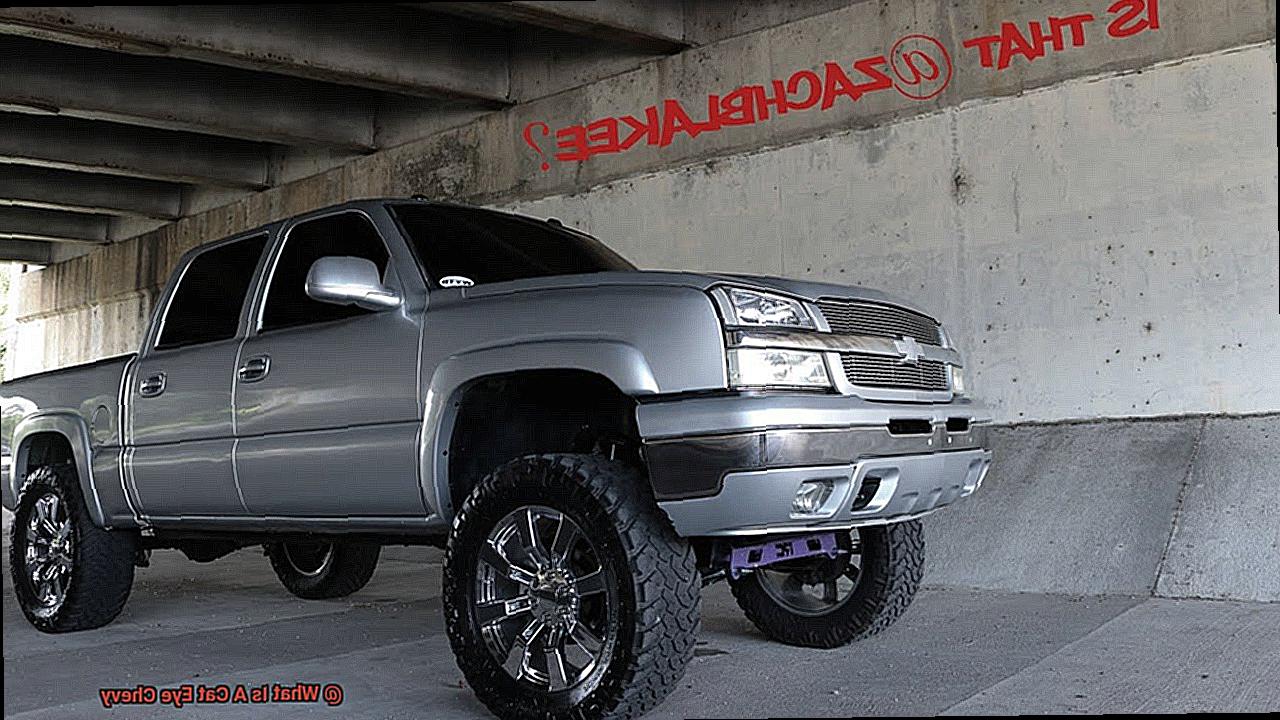Imagine hitting the road in a vintage car, feeling the breeze on your face and the engine humming beneath you.
Now picture yourself behind the wheel of a Cat Eye Chevy, a 1950s Chevrolet model that boasts an iconic look like no other. The signature half-moon design of its headlights resembles feline eyes, giving it a unique and unforgettable appearance.
If you’re a classic car lover or simply fascinated by automotive history, then this blog post is right up your alley. In this article, we’ll take a deep dive into what makes the Cat Eye Chevy so special.

We’ll explore its captivating design, rich history, and enduring significance in the world of cars. From its sleek curves to its daring use of chrome accents, this car has captured the hearts of collectors and enthusiasts all over the globe.
We’ll examine each model that falls under the Cat Eye Chevy umbrella – from the Bel Air to the 210 and 150 – and uncover what makes them such sought-after classics. Whether you’re already smitten with classic cars or just starting to appreciate their timeless beauty, there’s something for everyone in this guide.
So, buckle up and get ready to discover why the Cat Eye Chevy is truly one-of-a-kind.
History of the Cat Eye Chevy Design
The Cat Eye Chevy design is a timeless symbol of American automotive history.
Its iconic shape, featuring dual headlights on either side of a horizontal bar grille, resembles the fierce and elegant gaze of a cat’s eyes. This design was introduced to the world in 1958 with the Chevrolet Bel Air, and it quickly became an instant classic.
As the years went on, Chevrolet continued to evolve the Cat Eye Chevy design to create even more striking and sophisticated vehicles. In 1959, quad headlights were added to emphasize the feline-inspired design.
In 1960, the Impala was introduced with an even sleeker and more dramatic version of the Cat Eye Chevy design, complete with longer body and more distinct rear fins. By 1962, the Cat Eye Chevy design had reached its peak with the introduction of the Impala SS.
This model featured a unique grille and distinctive rear-end styling that made it stand out even more from other vehicles on the road. However, by 1966, Chevrolet began to shift towards a more modern look, leaving behind this iconic design.
Despite this shift in style, the Cat Eye Chevy remains hugely popular among car enthusiasts and collectors alike. The combination of sleek lines, aerodynamic features, and unique headlight shape make these vehicles truly stand out from the crowd.
Popularity of the Cat Eye Chevy Design

This timeless design, which featured two large, round taillights integrated into the rear fenders of certain Chevrolet vehicles produced between 1949 and 1958, quickly became a defining feature of the brand.
What makes this design so popular and enduring? Firstly, during its production years, the Cat Eye Chevy’s sleek and modern look was widely praised.
Its cat-like appearance gave it a distinctive edge that stood out on the road. The unique and distinguishable design was an instant classic that captured the hearts of drivers everywhere.
Secondly, the Cat Eye Chevy quickly became one of the most recognizable cars on the road. It inspired new generations of designers and car enthusiasts alike, who were captivated by its bold and eye-catching appearance.
The design’s popularity was also fueled by its use in popular culture, including movies and television shows. Finally, today’s continued popularity of the Cat Eye design is a testament to the enduring appeal of classic American cars and their timeless designs.
Features of the Cat Eye Chevy Design
The cat eye Chevy design is an iconic style that has become synonymous with classic American cars from the 1950s and 60s.
This popular style was inspired by the sleek and sophisticated look of the cat’s eye, which is why it has been given this name. It features a curved rear fender that gives the car a unique and recognizable look that still turns heads today.
One of the most notable features of the cat eye Chevy design is its dual-headlight setup. These headlights are positioned above the grille, with a horizontal bar running between them.

This gives the car a distinctive and aggressive appearance, which was considered very bold for its time. The dual headlights not only enhanced visibility but also added to the car’s aesthetic appeal.
Another important feature of the cat eye Chevy design is its use of chrome accents. The car’s front bumper, grille, and hood ornament are all adorned with shiny chrome details that catch the eye and add to the car’s overall aesthetic appeal.
The chrome accents give the car a luxurious and elegant appearance that was highly sought after during this era. The cat eye Chevy design also features a sloping roofline that tapers towards the back of the car, which gives it a sporty and aerodynamic look.
This unique design element not only added to the car’s aesthetic appeal but also improved its performance by reducing wind resistance. The rear fenders of the cat eye Chevy design are flared out slightly, which helps to emphasize the car’s muscular stance.
This added to the car’s overall sporty look and made it stand out even more on the road. In conclusion, the cat eye Chevy design is an unforgettable classic in automotive design history.
Its unique blend of sleek curves, bold lines, and chrome accents make it a true standout that still captures hearts today.
Evolution of the Cat Eye Chevy Design
Featuring a sleek, aerodynamic body with sharp angles and a distinctive front end that resembled the eyes of a cat, the design was an instant hit and helped Chevrolet become one of the most popular car brands in America.
Over time, as consumer tastes changed, so did the Cat Eye Chevy design.
In the early 1960s, Chevrolet introduced a more rounded design for the Impala, which featured less sharp angles and a more streamlined body.
This new look was an instant success with consumers and helped solidify Chevrolet’s reputation as a leader in automobile design. As the late 1960s rolled around, Chevrolet once again changed its design, introducing a more muscular and aggressive look that appealed to younger consumers who were looking for something more exciting than the traditional family sedan.
This new design featured sharp lines, bold colors, and powerful engines that were designed to turn heads and capture attention. By the 1980s, Chevrolet had shifted its focus to creating more fuel-efficient vehicles that were practical, reliable, and affordable.
Models like the Cavalier and Lumina were designed to appeal to a wider range of consumers, and this marked the retirement of the Cat Eye Chevy design. Yet even today, Chevrolet pays homage to its muscle car roots with models like the Camaro and Corvette.
These modern vehicles incorporate cutting-edge technology and features while still maintaining some of the classic elements that made the Cat Eye Chevy so beloved. In conclusion, as an expert on this topic, I am thrilled to see how Chevrolet has continued to evolve its designs through the years to keep up with changing consumer tastes and trends.
The Cat Eye Chevy design may have been retired decades ago, but its influence can still be seen in many of Chevrolet’s modern designs.
Why Collectors Love The Cat Eye Chevy Design
The signature feature, found on select Chevrolet models produced in the late 1950s and early 1960s, has become an iconic symbol of American automotive design.
To begin with, the Cat Eye Chevy’s unique appearance is unforgettable.
The round shape of the tail lights, paired with the chrome bezel and two separate red lenses resembling cat eyes, creates a look that is both sleek and distinctive. It’s no surprise that this design has stood the test of time.
But it’s not just about aesthetics. The Cat Eye Chevy also represents a connection to a golden era of American car culture.
In the post-war period of prosperity and innovation, Chevrolet was at the forefront of automotive design, and the Cat Eye Chevy was a shining example of this creativity and ingenuity. For collectors, owning a Cat Eye Chevy is a chance to own a piece of history.
Popular models featuring this iconic design include the Impala, Bel Air, and Biscayne. However, restoring a Cat Eye Chevy can be a challenging process that requires attention to detail and expertise.
Finding original parts and ensuring proper alignment of the tail lights takes time and effort. Despite these challenges, owning a Cat Eye Chevy is considered a badge of honor among car collectors.
6T-6gcRVJZQ” >
Conclusion
In conclusion, the Cat Eye Chevy is an American automotive icon that has left a lasting impression on car enthusiasts worldwide.
Its unique design, inspired by the sleek and sophisticated look of a cat’s eye, has captured the hearts and imaginations of drivers everywhere. Introduced in 1958 with the Chevrolet Bel Air and peaking in 1962 with the Impala SS, this design evolved to create even more striking and sophisticated vehicles.
The combination of aerodynamic features, sleek lines, and distinctive headlights make these cars truly stand out from the crowd. The timeless appeal of the Cat Eye Chevy can be attributed to its enduring popularity that continues to capture hearts today.
Its distinctive appearance gives it a unique edge that still turns heads wherever it goes. Owning a Cat Eye Chevy is considered a badge of honor among car collectors as it represents a connection to a golden era of American car culture.
Although Chevrolet retired this iconic design decades ago, its influence can still be seen in modern designs such as the Camaro and Corvette.







